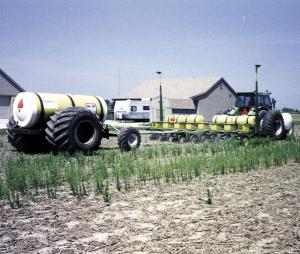2003 - Volume #27, Issue #1, Page #04
[ Sample Stories From This Issue | List of All Stories In This Issue | Print this story
| Read this issue]
Trailing Fertilizer Tank Saves Time At Planting
 |
Long time no-tillers, the Myers apply all of their nitrogen at planting. They had been using small starter fertilizer tanks on their planter to put on 65 gal. of 28 percent liquid nitrogen per acre.
The fertilizer trailer was built from the frame of an old C2 Gleaner combine. "Everything but the frame went to the scrap yard," Bob says.
They turned the frame upside down and put the steering wheels up front. They extended the frame to hold the 1,100-gal. tank and attached a long tongue on front that attaches to the steering axle. "The frame is made of 2 by 6-in. steel tubing and is welded in place so the top is flush with the rear axle. It extends about 4 ft. behind the axle so there's more weight on the back axle," Bob says.
To mount the tank on the frame, they made some saddle brackets and then strapped it on with steel bands in the front, center and rear of the tank.
The tongue is also made out of 2 by 6 steel tubing. It's 16 ft. long and attaches to the tie rods on the old frame's steering axle, so it trails well behind the planter, following closely on tight turns at the end of the field. "At 16 ft., you can almost turn back into the same tracks without a problem," Bill says.
The Myers brothers use the liquid fertilizer pump on their planter to pump 28 percent liquid nitrogen from the tank to the planter.
To minimize compaction, the men used big flotation tires on the rear axle.
"When we used just the four small tanks on the planter for nitrogen, we were always stopping to fill them. When they were full, their weight caused the planter to run deeper. As the tanks emptied, it ran shallower," Bob tells.
"Now, we fill the tanks with liquid fertilizer and set the planting depth accordingly. We use the fertilizer from the trailer only, so the planter weight never varies," he continues. At 65 gal. per acre, the 1100 gal. tank on the trailer allows them to cover 16 acres before they have to stop to refill, saving them a lot of time.
They paid $125 for the old tank at a salvage yard and spend roughly $80 for new steel and parts, so the total cost of the project, excluding their time in putting it together, was just over $200.
Contact: FARM SHOW Followup, Bill and Bob Myers, 6810 Cedar Pt. Rd., Oregon, Ohio 43618 (ph 419 836-9387; E-mail: notil1@juno.com).

Click here to download page story appeared in.

Click here to read entire issue
To read the rest of this story, download this issue below or click here to register with your account number.




